CS DACIA
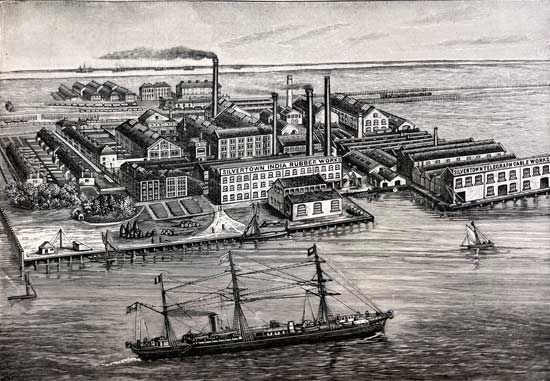
Telegraph Ship Dacia off the Silvertown Works (c.1869) |
Dacia was launched in 1867, and converted for cable use in 1869 by Sir Charles Bright, initially for use on the West India cables. The ship was cut in half and increased in length by 40 feet to provide room for a large cable tank amidships, and was also strengthened by a broad iron belt on her sides from stem to stern.
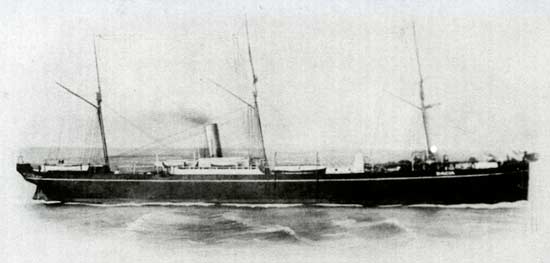
CS Dacia, date unknown |
These records of the Dacia, from an article published in The Telegraphic Journal and Electrical Review on 10 June 1882, give an idea of the range of the ship's activities:
| Undertaking |
Date left Silvertown |
Date arrived back at Silvertown |
| Chartered by GPO |
4 May 1879 |
25 Jul 1879 |
| Marseilles, France - Algiers, Algeria cable expedition and repairs to Lizard, England - Bilbao, Spain cable |
3 Sep 1879 |
16 Nov 1879 |
| Chartered by GPO |
1 Jan 1880 |
Returned to Falmouth 9 Feb 1880 |
| Repairs to Lizard - Bilbao cable |
Left Falmouth 13 Feb 1880 |
22 Mar 1880 |
| Marseilles, France - Algiers, Algeria cable expedition |
11 Sep 1880 |
18 Oct 1880 |
| Mexican Telegraph Co cable expedition and repairs to the Havana - Key West cables |
6 Dec 1880 |
26 Jul 1881 |
| Chartered by GPO |
14 Aug 1881 |
7 Nov 1881 |
| Central & South American Telegraph Co expedition |
15 Nov 1881 |
1 Jun 1882 |
| During the period April - September 1880 Dacia underwent a major overhaul, which new deck housing, steam sounding gear, electric machinery and lights being installed. |
For a first-hand story of life on Dacia in the 1890s, read Captain Basil
Combe's diaries.
The ship had a long and successful career as a cable layer, but came to a sad end during the First World War. Although cable ships were merchant vessels
they were considered legitimate war targets and a number were sunk during
both world wars.
CS Dacia, at the time of
her sinking during WWI, was in the process of diverting the German South American
cable into Brest. The date of 3 December 1916 shown on the photographs
below is correct; the date of 1915 given elsewhere is incorrect.
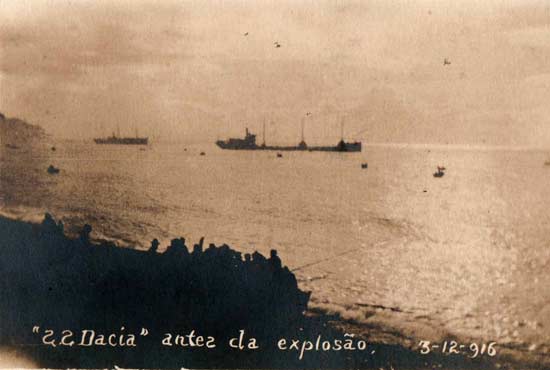
SS Dacia is on the left of the picture.
Inscription reads:
"SS Dacia antes da explosao 3.12.(1)916."
( "SS Dacia before the explosion 3 12 [1]916.") |
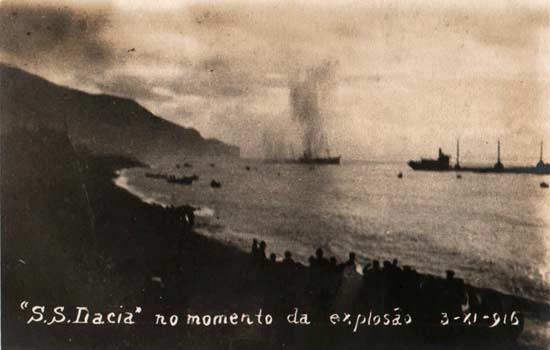
Inscription reads:
"SS Dacia no momento da explosao 3 xi (1)916."
("SS Dacia during the explosion 3 xi [1]916.") |
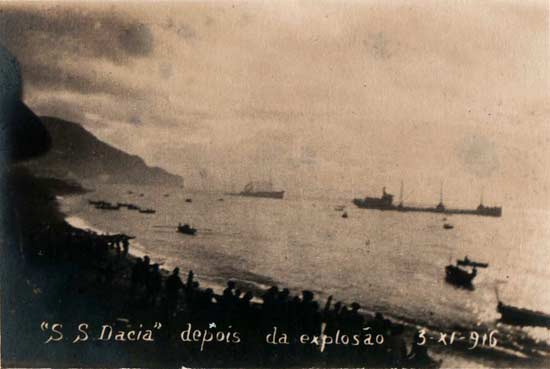
Inscription reads:
"SS Dacia depois da explosao 3 xi (1)916."
( "SS Dacia after the explosion 3 xi [1]916.")
Dacia is already settling by the stern. |
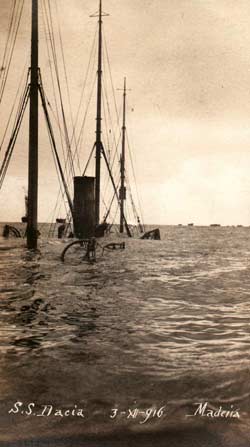
Inscription reads:
"SS Dacia 3.xii [1]916 Madeira."
Dacia's final resting place. |
Further information on the sinking of CS Dacia may be found at the Madeira History website (archive copy; original no longer on line).
During the war CS Dacia's cable diversion work was of course kept secret. But at the fifty-sixth Ordinary General Meeting of the India Rubber, Gutta Percha, and Telegraph Works Company, 18 December 1919, the Chairman of the company, Major Leonard Darwin, presented this report on the operations:
There is one other matter connected with the past history of the company to which I wish to allude. Since the war began I have on more than one occasion said that we had been doing work for the French Government, but I gave no details. Early in the war we were employed in diverting the German Emden-Teneriffe cable into St. Nazaire and in making several repairs to French Government cables — dangerous work, which ended more than two years afterwards with the sinking of our ship and the accompanying French man-of-war in Funchal Harbour, Madeira, by a German submarine.
Far the most important work accomplished by our ship, the Dacia, under the supervision of submarine cable engineers Mr. Crawford and Mr. Robinson successively, was the diversion of the rest of the German Emden-Teneriffe cable so as to connect Brest with Casablanca, in Morocco, and the diversion of the German Teneriffe-Monrovia cable so as to connect Morocco with Senegal. The Emden-Teneriffe cable was first cut off Brest, a length picked up and relaid into Brest. The same operation on a larger scale was then performed off Casablanca, with the result that, after the necessary connections had been made, this second portion of the German Emden-Teneriffe cable was converted into a French Brest-Casablanca cable. Similar work was carried out on the German Teneriffe-Monrovia cable, thus extending the French cable from Casablanca, to Dakar in Senegal. Our cable engineers, Mr. Crawford and Mr. Robinson, after fully considering the difficulties, held that these were possible operations; there were no signs. that any other English expert, whether governmental or in private employment, shared in this view; whilst the electrical advisers to the French Government declared the scheme to be impracticable owing to the depth in which the cable lay.
Imagine fishing for a cable in pitch darkness — not that any light at the bottom could have made matters easier — the cable lying about as far below the ship as is the Tower of London from Buckingham Palace; imagine trying to cut the cable in these circumstances in the hope of being able to haul up one of the two ends thus set free to the surface; imagine pulling it up vertically through these nearly three miles of water, then steaming away. whilst continuing to drag up the cable from the bottom, coiling it up on board without any kinks Or unperceived injuries; and finally relaying it exactly where required; imagine all this, and I think scepticism as to the possibility of success becomes more than excusable. If our information is correct, this remarkable performance is absolutely unique in the history of submarine cable enterprise, and this whether we look to the length of the cable lifted, 1,200 miles, or to the average depth of the water in which it lay.
Our staff without exception worked splendidly, but the chief credit for the success must be awarded to our managing director, Mr. C.H. Gray. He conceived the scheme and advised the Board to take the risks involved; he persuaded the French Government to neglect the doubts expressed by their own expert advisers; and he-inspired all hands with the energy essential for success in such a feat.
I am very glad to say that the position was fully realised by the French Government, for our Foreign Office has recently transmitted to Mr. Gray the Cross of Chevalier of the Legion of Honour, which had been awarded to him by the President of the French Republic for his services during the war. I know you will all join with me in giving him our hearty congratulations. (Cheers.) It is only his native modesty that prevents his wearing the red button to-day
[The Times, London, 19 December 1919]
Mr. Robinson, mentioned in the article above, was probably Frederick W. Robinson of the IRGP's staff who had a long career in the cable industry. In 1884 he was Chief Officer of CS International, laying a cable from Tenerife to Senegal for the Spanish government; in 1893 he was conferred with the honorary testimonioal of the Royal Humane Society for helping save the life of a cablehand on CS Silvertown; in 1908 he is listed as a witness in the Minutes of Evidence of a UK government committee on Injuries to Submarine Cables; and during WWI he served on CS Dacia as described above.
A private collector in the UK has kindly provided these images of Robinson's WWI medals and whistle:
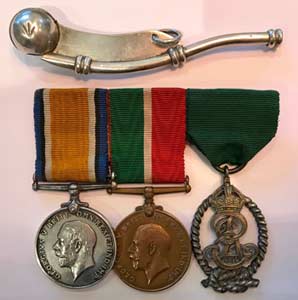 |
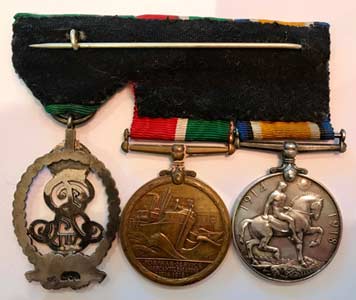 |
The center medal has the legend on the reverse:
"For War Service, Mercantile Marine, 1914-1918 |
CABLE WORK
1870 |
Santiago de Cuba, Cuba - Holland Bay, Jamaica |
1870 |
Colon, Panama - Kingston, Jamaica |
1870 |
St. Thomas, DWI - San Juan, Puerto Rico |
1871 |
St Thomas - St Kitts - Antigua - Basse Terre, Guadeloupe - Dominica - Martinique - St Lucia - St Vincent - Barbados: St Vincent - Grenada - Trinidad - Georgetown, British Guiana |
1871 |
The Lizard, England - Bilbao, Spain |
1872 |
The Lizard, England - Bilbao, Spain |
1872 |
Jamaica - Puerto Rico |
1873 |
Key West, USA - Havana, Cuba |
1874 |
Marseilles, France - Barcelona, Spain |
1875 |
Valparaiso - La Serena - Caldera - Antofagasta - Iquique - Arica, Chile - Lima, Peru |
1879 |
Marseilles, France - Algiers, Algeria |
1880 |
Marseilles, France - Algiers, Algeria |
1881 |
Galveston, Texas, USA - Tampico, Mexico - Vera Cruz, Mexico |
1882 |
Galveston, Texas, USA - Coatzacoalcos, Mexico |
1883 |
Fishguard, Wales - Blackwater, Ireland |
1883 |
St Louis, Senegal - Tenerife |
1883 |
Cadiz - Las Palmas: Confital - Regla: Garachio - Santa Cruz la Palma |
1885 |
Havana, Cuba - Key West |
1885 |
Bathurst, Gambia - St Jago, Cameroons - St Vincent, Cape Verde Islands |
1885 |
St Louis, Senegal - Dakar, Senegal - Bathurst, Gambia - Boloma, Portuguese Guinea - Bissau - Konakry, French Guinea - Freetown, Sierra Leone: Bassam, Ivory Coast - Accra, Gold Coast - Cotonou, Dahomey - St Thomas (Island) - Luanda, Angola: |
1885 |
Bushire - Jask |
1899 |
Key West - Miami Beach, Florida |
CABLE REPAIRS
1879 |
The Lizard - Bilbao |
1880 |
The Lizard - Bilbao |
1880-81 |
Havana - Key West |
OTHER DUTIES
1879 |
Chartered by the GPO, 4 May - 25 July |
1880 |
Chartered by the GPO, 1 January - 9 February |
1881 |
Chartered by the GPO, 14 August - 7 November |
|

